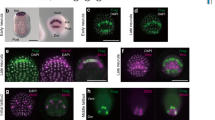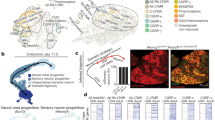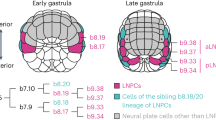Abstract
Neural crest cells (NCCs) can adopt different neuronal fates. In NCCs, neurogenin-2 promotes sensory specification but does not specify different subclasses of sensory neurons. Understanding the gene cascades that direct Trk gene activation may reveal mechanisms generating sensory diversity, because different Trks are expressed in different sensory neuron subpopulations. Here we show in chick and mouse that the Runt transcription factor Runx1 promotes axonal growth, is selectively expressed in neural crest–derived TrkA+ sensory neurons and mediates TrkA transactivation in migratory NCCs. Inhibition of Runt activity depletes TrkA expression and leads to neuronal death. Moreover, Runx1 overexpression is incompatible with multipotency in the migratory neural crest but does not induce expression of pan-neuronal genes. Instead, Runx1-induced neuronal differentiation depends on an existing neurogenin2 proneural gene program. Our data show that Runx1 directs, in a context-dependent manner, key aspects of the establishment of the TrkA+ nociceptive subclass of neurons.
This is a preview of subscription content, access via your institution
Access options
Subscribe to this journal
Receive 12 print issues and online access
$209.00 per year
only $17.42 per issue
Buy this article
- Purchase on Springer Link
- Instant access to full article PDF
Prices may be subject to local taxes which are calculated during checkout






Similar content being viewed by others
References
Carr, P.A. & Nagy, J.I. Emerging relationships between cytochemical properties and sensory modality transmission in primary sensory neurons. Brain Res. Bull. 30, 209–219 (1993).
Cheung, M. et al. The transcriptional control of trunk neural crest induction, survival, and delamination. Dev. Cell 8, 179–192 (2005).
Kim, J., Lo, L., Dormand, E. & Anderson, D.J. SOX10 maintains multipotency and inhibits neuronal differentiation of neural crest stem cells. Neuron 38, 17–31 (2003).
Serbedzija, G.N., Fraser, S.E. & Bronner-Fraser, M. Pathways of trunk neural crest cell migration in the mouse embryo as revealed by vital dye labelling. Development 108, 605–612 (1990).
Kasemeier-Kulesa, J.C., Kulesa, P.M. & Lefcort, F. Imaging neural crest cell dynamics during formation of dorsal root ganglia and sympathetic ganglia. Development 132, 235–245 (2005).
Lawson, S.N. & Biscoe, T.J. Development of mouse dorsal root ganglia: an autoradiographic and quantitative study. J. Neurocytol. 8, 265–274 (1979).
Vogel, K.S. & Davies, A.M. The duration of neurotrophic factor independence in early sensory neurons is matched to the time course of target field innervation. Neuron 7, 819–830 (1991).
Ernfors, P., Merlio, J.P. & Persson, H. Cells Expressing mRNA for neurotrophins and their receptors during embryonic rat development. Eur. J. Neurosci. 4, 1140–1158 (1992).
Crowley, C. et al. Mice lacking nerve growth factor display perinatal loss of sensory and sympathetic neurons yet develop basal forebrain cholinergic neurons. Cell 76, 1001–1011 (1994).
Smeyne, R.J. et al. Severe sensory and sympathetic neuropathies in mice carrying a disrupted Trk/NGF receptor gene. Nature 368, 246–249 (1994).
Ernfors, P., Lee, K.F., Kucera, J. & Jaenisch, R. Lack of neurotrophin-3 leads to deficiencies in the peripheral nervous system and loss of limb proprioceptive afferents. Cell 77, 503–512 (1994).
Patel, T.D., Jackman, A., Rice, F.L., Kucera, J. & Snider, W.D. Development of sensory neurons in the absence of NGF/TrkA signaling in vivo. Neuron 25, 345–357 (2000).
Patel, T.D. et al. Peripheral NT3 signaling is required for ETS protein expression and central patterning of proprioceptive sensory afferents. Neuron 38, 403–416 (2003).
Moqrich, A. et al. Expressing TrkC from the TrkA locus causes a subset of dorsal root ganglia neurons to switch fate. Nat. Neurosci. 7, 812–818 (2004).
Coffman, J.A. Runx transcription factors and the developmental balance between cell proliferation and differentiation. Cell Biol. Int. 27, 315–324 (2003).
Levanon, D. et al. The Runx3 transcription factor regulates development and survival of TrkC dorsal root ganglia neurons. EMBO J. 21, 3454–3463 (2002).
Inoue, K. et al. Runx3 controls the axonal projection of proprioceptive dorsal root ganglion neurons. Nat. Neurosci. 5, 946–954 (2002).
Levanon, D. et al. Spatial and temporal expression pattern of Runx3 (Aml2) and Runx1 (Aml1) indicates non-redundant functions during mouse embryogenesis. Mech. Dev. 109, 413–417 (2001).
Perez, S.E., Rebelo, S. & Anderson, D.J. Early specification of sensory neuron fate revealed by expression and function of neurogenins in the chick embryo. Development 126, 1715–1728 (1999).
Hamburger, V. & Hamilton, H.L. A series of normal stages in the development of the chick embryo. J. Morphol. 88, 49–92 (1951).
Hjerling-Leffler, J. et al. The boundary cap: a source of neural crest stem cells that generate multiple sensory neuron subtypes. Development 132, 2623–2632 (2005).
Falk, A. et al. Gene delivery to adult neural stem cells. Exp. Cell Res. 279, 34–39 (2002).
Sholl, D.A. Dendritic organization in the neurons of the visual and motor cortices of the cat. J. Anat. 87, 387–406 (1953).
Bae, S.C. et al. PEBP2 alpha B/mouse AML1 consists of multiple isoforms that possess differential transactivation potentials. Mol. Cell. Biol. 14, 3242–3252 (1994).
Meyers, S., Lenny, N. & Hiebert, S.W. The t(8;21) fusion protein interferes with AML-1B-dependent transcriptional activation. Mol. Cell. Biol. 15, 1974–1982 (1995).
Tanaka, T. et al. An acute myeloid leukemia gene, AML1, regulates hemopoietic myeloid cell differentiation and transcriptional activation antagonistically by two alternative spliced forms. EMBO J. 14, 341–350 (1995b).
Wang, Q. et al. Disruption of the Cbfa2 gene causes necrosis and hemorrhaging in the central nervous system and blocks definitive hematopoiesis. Proc. Natl. Acad. Sci. USA 93, 3444–3449 (1996).
Okuda, T., van Deursen, J., Hiebert, S.W., Grosveld, G. & Downing, J.R. AML1, the target of multiple chromosomal translocations in human leukemia, is essential for normal fetal liver hematopoiesis. Cell 84, 321–330 (1996).
Britsch, S. et al. The transcription factor Sox10 is a key regulator of peripheral glial development. Genes Dev. 15, 66–78 (2001).
Ma, L., Lei, L., Eng, S.R., Turner, E. & Parada, L.F. Brn3a regulation of TrkA/NGF receptor expression in developing sensory neurons. Development 130, 3525–3534 (2003).
Ma, L., Merenmies, J. & Parada, L.F. Molecular characterization of the TrkA/NGF receptor minimal enhancer reveals regulation by multiple cis elements to drive embryonic neuron expression. Development 127, 3777–3788 (2000).
Komori, T. et al. Targeted disruption of Cbfa1 results in a complete lack of bone formation owing to maturational arrest of osteoblasts. Cell 89, 755–764 (1997).
Otto, F. et al. Cbfa1, a candidate gene for cleidocranial dysplasia syndrome, is essential for osteoblast differentiation and bone development. Cell 89, 765–771 (1997).
Ducy, P., Zhang, R., Geoffroy, V., Ridall, A.L. & Karsenty, G. Osf2/Cbfa1: a transcriptional activator of osteoblast differentiation. Cell 89, 747–754 (1997).
Theriault, F.M. et al. Role for Runx1 in the proliferation and neuronal differentiation of selected progenitor cells in the mammalian nervous system. J. Neurosci. 25, 2050–2061 (2005).
Theriault, F.M., Roy, P. & Stifani, S. AML1/Runx1 is important for the development of hindbrain cholinergic branchiovisceral motor neurons and selected cranial sensory neurons. Proc. Natl. Acad. Sci. USA 101, 10343–10348 (2004).
Levi-Montalcini, R. The nerve growth factor 35 years later. Science 237, 1154–1162 (1987).
Gerrero, M.R. et al. Brn-3.0: a POU-domain protein expressed in the sensory, immune, and endocrine systems that functions on elements distinct from known octamer motifs. Proc. Natl. Acad. Sci. USA 90, 10841–10845 (1993).
Huang, E.J. et al. POU domain factor Brn-3a controls the differentiation and survival of trigeminal neurons by regulating Trk receptor expression. Development 126, 2869–2882 (1999).
Fedtsova, N.G. & Turner, E.E. Brn-3.0 expression identifies early post-mitotic CNS neurons and sensory neural precursors. Mech. Dev. 53, 291–304 (1995).
McEvilly, R.J. et al. Requirement for Brn-3.0 in differentiation and survival of sensory and motor neurons. Nature 384, 574–577 (1996).
Xiang, M., Gan, L., Zhou, L., Klein, W.H. & Nathans, J. Targeted deletion of the mouse POU domain gene Brn-3a causes selective loss of neurons in the brainstem and trigeminal ganglion, uncoordinated limb movement, and impaired suckling. Proc. Natl. Acad. Sci. USA 93, 11950–11955 (1996).
Rifkin, J.T., Todd, V.J., Anderson, L.W. & Lefcort, F. Dynamic expression of neurotrophin receptors during sensory neuron genesis and differentiation. Dev. Biol. 227, 465–480 (2000).
Eng, S.R., Lanier, J., Fedtsova, N. & Turner, E.E. Coordinated regulation of gene expression by Brn3a in developing sensory ganglia. Development 131, 3859–3870 (2004).
Zirlinger, M., Lo, L., McMahon, J., McMahon, A.P. & Anderson, D.J. Transient expression of the bHLH factor neurogenin-2 marks a subpopulation of neural crest cells biased for a sensory but not a neuronal fate. Proc. Natl. Acad. Sci. USA 99, 8084–8089 (2002).
Nibu, K., Li, G., Kaga, K. & Rothstein, J.L. bFGF induces differentiation and death of olfactory neuroblastoma cells. Biochem. Biophys. Res. Commun. 279, 172–180 (2000).
Tanaka, K. et al. Increased expression of AML1 during retinoic-acid-induced differentiation of U937 cells. Biochem. Biophys. Res. Commun. 211, 1023–1030 (1995a).
Oakley, R.A. et al. Neurotrophin-3 promotes the differentiation of muscle spindle afferents in the absence of peripheral targets. J. Neurosci. 17, 4262–4274 (1997).
von Bartheld, C.S. et al. Retrograde transport of neurotrophins from the eye to the brain in chick embryos: roles of the p75NTR and trkB receptors. J. Neurosci. 16, 2995–3008 (1996).
Lefcort, F., Clary, D.O., Rusoff, A.C. & Reichardt, L.F. Inhibition of the NT-3 receptor TrkC, early in chick embryogenesis, results in severe reductions in multiple neuronal subpopulations in the dorsal root ganglia. J. Neurosci. 16, 3704–3713 (1996).
Acknowledgements
We thank C. Tello for technical assistance and A. Käller for secretarial assistance. This work was supported by the Swedish Medical Research Council, the Swedish Foundation for Strategic Research (grant from the Center of Excellence in Developmental Biology), the Hedlunds Foundation, AstraZeneca Mölndal and the US Public Health Service (grant NS 16033).
Author information
Authors and Affiliations
Corresponding author
Ethics declarations
Competing interests
The authors declare no competing financial interests.
Supplementary information
Supplementary Fig. 1
RuntB expression in chick cranial sensory ganglia at stage HH29. (PDF 35108 kb)
Supplementary Fig. 2
Characterisation of proneural gene expression in bNCSCs and a cell autonomous function of Runx1 in cell survival. (PDF 383 kb)
Supplementary Fig. 3
Electroporation of DNA constructs into the chick leads to overexpression in cell populations of neural crest origin. (PDF 11292 kb)
Supplementary Fig. 4
Blocking Runt activity is incompatible with neuronal differentiation in the DRG. (PDF 2634 kb)
Supplementary Fig. 5
Identification of a conserved Runt binding site in vertebrate TrkA minimal enhancers and in vitro transactivation of the promoter by Runx1. (PDF 3148 kb)
Supplementary Fig. 6
Genetic interaction between Runx1 and other transcriptional regulators during sensory neuron development. DRG sensory neurons are derived from NCCs. (PDF 545 kb)
Rights and permissions
About this article
Cite this article
Marmigère, F., Montelius, A., Wegner, M. et al. The Runx1/AML1 transcription factor selectively regulates development and survival of TrkA nociceptive sensory neurons. Nat Neurosci 9, 180–187 (2006). https://doi.org/10.1038/nn1631
Received:
Accepted:
Published:
Issue Date:
DOI: https://doi.org/10.1038/nn1631
This article is cited by
-
Nociception, Transcriptomics ET CETERA: NOCICEPTRA
Pflügers Archiv - European Journal of Physiology (2022)
-
Epigenetic control of melanoma cell invasiveness by the stem cell factor SALL4
Nature Communications (2021)
-
Satellite Glial Cells Give Rise to Nociceptive Sensory Neurons
Stem Cell Reviews and Reports (2021)
-
Identification of molecular signatures specific for distinct cranial sensory ganglia in the developing chick
Neural Development (2016)
-
Positional differences of axon growth rates between sensory neurons encoded by runx3
The EMBO Journal (2012)



